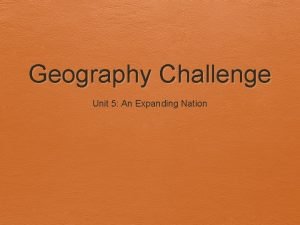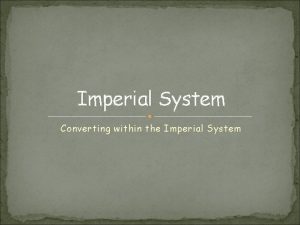Name Class Date Unit 3 Geography Challenge Imperial



- Slides: 3

Name: ________ Class: ________ Date: ________ Unit 3 Geography Challenge – Imperial China

Name: ________ Class: ________ Date: ________ Unit 3 Geography Challenge – Imperial China Directions: Read “Setting the Stage” and refer to the map on page 178 in your textbook in order to complete the Unit 3 Geography Challenge. Shading and Labeling: 1. Shade blue and label the… q Sea of Japan (East Sea). q Pacific Ocean. q Yellow Sea. q East China Sea. q South China Sea. q Bay of Bengal. q Indian Ocean. 2. Shade yellow and label the… q Taklimakan Desert. q Gobi Desert. 3. Trace blue and label the… q Huang He (Yellow River). q Chang Jiang (Yangtze River). 4. Shade green and label the… q Chang Jiang Basins. q North China Plain. 5. Draw a series/strings of triangles and shade them brown to represent the… q Tian Shan Mountains. q Kunlun Shan Mountains. q Himalaya Mountains. 6. Shade brown and label the… q Plateau of Tibet. Questions: 7. Suppose traders were traveling from China to the Mediterranean Sea. Which physical features in China would they need to cross in order to reach the Mediterranean Sea? 8. The North China Plain and the Chang Jiang Basins were heavily populated. Why do you think this is so?

9. During the 200 s B. C. E. a Chinese emperor ordered his people to connect a series of walls that had been built by previous rulers. The completed project, known as the Great Wall of China, extends along the northern border of China. This was meant to protect the Chinese from invaders from the north. Thinking about China’s geography, why do you think the emperor did not create similar projects in the east, south, and west of China? 10. It took around 500 years for Buddhism, a type of religion, to reach China from India. It took nearly twice that long for Christianity to reach China from Europe. What geographical features might explain this difference? 11. Examine the geography of the land just above the North China Plain. Why might people from this area of China have attacked the people living around the Huang He (Yellow River)? 12. How did China’s geography influence the directions in which rulers/dynasties of China chose to expand their empire? You may want to investigate the two maps on page 179 in your textbook to help you develop your response. 13. Why do you think the earliest cities in China developed around the Huang He (Yellow River) and the Chang Jiang (Yangtze River)?





